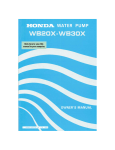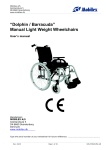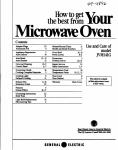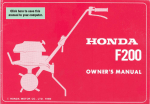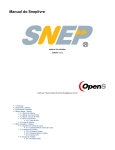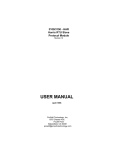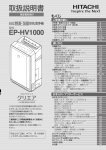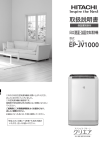Download Honda Power Equipment HR173 Lawn Mower User Manual
Transcript
Thank you for purchasing a Honda mower. This manual covers operation and maintenance of Honda HR173 rotary mowers; type PDA (manually propelled, rear bag). Honda HR173 mowers meet CPSC blade safety requirements for walkbehind rotary power mowers. Honda without Motor Co., Ltd. reserves the right to make’changes notice and without incurring any obligation. No part of this publication may be reproduced without This manual should be considered a permanent should remain with the mower if it is resold. Pay special attention Indicates of life if instructions to statements preceded a strong possibility are not followed. written at any time permission. part of the mower by the following of severe personal and words; injury or loss CAUTION: Indicates a possibility that equipment or property damage could result if instructions are not followed. ‘I’ NOTE: Gives helpful information. If a problem should arise, or if you have any questions consult an authorized Honda dealer. HONDA MOTOR CO., LTD. 1985, ALL RIGHTS about your mower, RESERVED 1 Honda rotary mowers are designed to give safe and dependable service if operated according to instructions and intended use: mowing (cutting) grass, and bagging cut grass when equipped with the grass bag. Any other use could be dangerous. . Read and understand the Owner’s Manual before operating the mower. Failure to do so could result in personal injury or equipment damage. l 2 ._ CONTENTS CONTENTS .................................................... 1 CAUTION LABEL LOCATION 2 GENERAL SAFETY .................................................................. ................................................ 3 COMPONENT IDENTIFICATION ........................................................................... 4 CONTROLS ........................................................................... 5 OPERATION 6 BEFORE YOU START THE MOWER ............................................ 7 STARTING AND STOPPING THE ENGINE .................................... l High altitude operation . ................................. ...................... ..................................................... 8 TRANSPORTING/STORAGE ...................................................................... 9 MAINTENANCE .............................................................. 10 TROUBLESHOOTING ................................................................... 11 SPECIFICATIONS 12 WARRANTY SERVICE ............................................................. 4 6 7 8 9 10 14 17 19 22 32 33 34 3 1. CAUTION LA.BEL LOCATIONS BLADE CONTROL WARNING n READ OWNER’S MANUAL BEFORE OPERATING n D0 NOT ALLOW ANYONE TO STAND IN FRONT OF MOWER n T0 PREVENT INJURY FROM THROWN ORJECTS: CLEAR AREA OF DEBRIS KEEP OTHERS AWAY ODO NOT REMOVE GUARDS q DO NOT START UNLESS REAR DOOR IS CLOSED OR BAG IS IN PLACE 4 HOLD AGAINST ENGINE. HANDLE RELEASE ‘BEFORE STARTING TO STOP ENGINE. [[ DANGER:KEEPHANDS and FEETAWAY ]] WARNING ~___..... SERIOUSINIURV.DO NOT WHENENlINE IS fHlNNING. 1 5 -I 2. GENERAL SAFETY l l l l l l Know how to stop the engine quickly and understand operation of all the controls. Never permit anyone to operate the mower without proper instruction. The rear shield is for your protection; keep it in place at all times. The blade is sharp and dangerous. Never put your hands or feet under the mower. Never tilt the mower to expose the blade while the engine is running. If you find it necessary to work on the blade or mower, stop the engine and remove the spark plug cap. Never stand in front of self-propelled mowers when the engine is running. Someone may accidentally engage the drive clutch. Clear the lawn of sticks, stones, or debris before mowing. Mow only in cleared areas in daylight or good artificial light. Protect yourself by wearing long trousers and appropriate shoes. Don’t wear l l 6 loose fitting clothing or sandals when mowing. Keep children and pets away from the mower at all times. If the blade strikes a stone, sprinkler head, etc., be sure the blade, blade holderwasher, woodruff key, fasteners, crankshaft, etc. are in good condition before continuing to mow. Replace any damaged parts. _ -’ 3. COMPONENT IDENTlFlCATlOiU RECOIL STARTER GRIP I I- FLYWHEEL BRAKE AIR CLEANER THROTTLE LEVER - GRASS BAG HANDLE CUTTING HEIGHT ADJUSTING OIL FILLER CAP DISCHARGE SPARK PLUG CAP A MUFFLER 7 4. CONTROLS. Throttle Lever Throttle positions: Flywheel START HI LO (CHOKE) Brake Lever (Black-painted lever) The flywheel brake lever must be moved forward and held against the handlebar to allow the engine to &art and run. When the flywheel brake lever is released, the engine stops. m If the Brake System fails to stop the engine, turn off the fuel valve and allow the engine to stop completely. Take the mower to an authorized Honda dealer for service. FLYWHEEL BRAKE LEVER 8 5. OPERATION This mower may be used either with the grass bag or without the grass bag. The following suggestions and rules are intended to help you operate your HR173 under the safest conditions possible. Be alert and exercise the same care using the mower as you would using any other power tool. Be especially careful when mowing uneven or rough ground. The mower may tilt, exposing the blade, and hidden objects could be thrown by the blade. Keep all four wheels on the ground. 0 Mow across slopes. Do not mow excessively steep slopes. l Control direction by the handle, not by foot pressure on the mower housing. l Keep a firm hold on the handle and walk, never run, with the mower. Don’t lag behind the machine or let it pull you. l CAUTION: l Use extra care when mowing around objects to keep the blade from striking them. Never deliberately mow over any object. l Stop the engine immediately if the blade hits an object or the mower starts to vibrate. Remove the spark plug cap (keep the wire away from the plug) and inspect for damage. 9 6. BEFORE YOU START THE IMOWER 1. Check the engine oil level. CAUTION: l Engine oil is a major factor affecting engine performance and service life. Non-detergent oil and 2-stroke engine oil are not recommended. l Running ,the engine with insufficient oil can cause serious engine damage. Use Honda-4-stroke, or an equivalent high detergent, premium quality motor oil certified to meet or exceed U.S. automobile manufacturers’ requirements for service classification SE or SF (Motor oils classified SE or SF will show this designation on the container). SAE low-40 is recommended for general, all temperature use. a. Place the mower on a level surface. b. Remove the oil filler cap and wipe the dipstick clean. c. Insert the dipstick into the oil filler neck, but do not screw it in. d. Check the oil level shown on the,dipstick. If near the lower level, fill to the upper level with the recommended oil. OIL FILLER CAP I 1 -30 720 -10 0 10 20 30 40°C UPPER LEVEL 1. 10 LO\;‘WERLEVEL 2. Check the fuel level. Your engine is designed to use any gasoline that has or ,that has number ( ’ ‘2 M ) of 86 or higher, tane number of 91 or higher. Gasoline pumps at service display the pump octane number. We recommend that you use unleaded fuel because it engine and spark plug deposits and extends the life of components. a pump octane a research ocstation normally produces fewer exhaust system Never use stale or contaminated gasoline or an oil/gasoline mixture. Avoid getting dirt, dust or water in the fuel tank. Use of a lower octane gasoline can cause persistent “pinging” or heavy “spark knock” (a metallic rapping noise) which, if severe, can lead to engine damage. CAUTION: If “spark knock” or “pinging” occurs at a steady engine speed under normal load, change brands of gasoline. If spark knock or pinging persists, consult your authorized Honda dealer. Failure to do so is considered misuse, and damage caused by misuse is. not covered by Honda’s Limited Warranty. Occasionally you may experience light spark knock while operating under heavy loads. This is no cause for concern, it simply means your engine is operating efficiently. liwml l Gasoline is extremely flammable and is explosive under certain conditions. l Refuel in a well-ventilated area with the engine stopped. Do not smoke or allow flames or sparks in the area where the engine is refueled or where gasoline is stored. l Do not overfill the fuel tank (there should be no fuel in the filler’neck). After refueling, make sure the tank cap is closed properly and securely. l Be careful not to spill fuel when refueling. Spilled fuel or fuel vapor may ignite. If any fuel is spilled, make sure the area is dry before starting the engine. l Avoid repeated or prolonged contact with skin or breathing of vapor. KEEP OUT OF REACH OF CHILDREN. Fuel tank capacity: 0.9 0 (0.24 US gal, 0.02 Imp gal) GASOLINES CONTAINING ALCOHOL If you decide to use a gasoline containing alcohol (gasohol), be sure it’s octane rating is at least as high as that recommended by Honda. There are two types of “gasohol”: one containing ethanol, and the other containing methanol. Do not use gasohol that contains more than 10% ethanol. Do not use gasoline containing methanol (methyl or wood alcohol) that does not also contain cosolvents and corrosion inhibitors for methanol. Never use gasoline containing more than 5%.methanol, ev.en if it has cosolvents and corrosion inhibitors. NOTE: l Fuel system damage or engine performance problems resulting from the use of fuels that contain alcohol is not covered under the warranty. Honda cannot endorse the use of fuels containing methanol since evidence of their suitability is as yet incomplete. l Before buying fuel from an unfamiliar station, try to find out if the fuel contains alcohol, if it does, confirm the type and percentage of alcohol used. If you notice any undesirable operating symptoms while using a gasoline that contains alcohol, or one that you think contains alcohol, switchto a gasoline that you know does not contain alcohol. ,. .:. _ : 12' . ‘.. . ” 3. Check the grass. bag for fraying, tears and clogged mesh. Wash the bag with water if necessary, and let it dry thoroughly. Grass will not chute properly without adequate ventilation through the bag. Make’Esure.the ‘. bag is properly installed. 4. Check the blade bolt for tightness. Torque: 3.0-3.5 kg-m (21.7-25.3 m’ remove ft-lb) To be certain that the engine will not start accidentally, the spark plug cap before performing this inspection. 5. Check the air cleaner element and clean it if it is dirty (p.25). AIR CLEANER 13 7. STARTING AND STOPPING THE ENGINE Starting the Engine Bmm the mower Exhaust gas contains poisonous carbon, monoxide. Never run in an enclosed area. Be sure to provide adequate ventilation. 1. Turn the fuel valve 2. Move NOTE: throttle the throttle ON. lever to START(CHOKE); If the engine is warm or the air temperature to LO as soon as the engine starts. is high, move the FUEL VALVE START (CHOKE) 3. Move the flywheel brake lever forward FLYWHEEL BRAKE LEVER 14 and hold it against the handlebar. 4. Pull the starter rope lightly until you feel resistance, then pull briskly. NOTE: l The engine will start more easily if the cutting blade is not in contact long, uncut grass. l Do not allow the rope to snap back; return it by hand. 5. After the engine .warms up, move the throttle with lever to HI. STAkTER NOTE: The throttle lever may be moved anywhere between HI and LO to adjust engine speed during operation. However, the engine may stall if the lever is at LO when mowing starts. 15 Flooded Engine If the engine won’t start after several pulls on the starter may be flooded. To clear a.flooded engine: 1. Turn off the fuel valve. 2. Remove the spark plug and dry it. When reinstalling the by hand until it seats. Then tighten it an additional l/8-1 spark plug wrench to compress the washer. 3. Move the throttle to HI, turn on the fuel valve and repeat “Starting the Engine”. Stopping the Engine 1. Release the flywheel brake lever. 2.Turn off the fuel valve. /( 16 FUEL VALVE rope, the engine plug, thread it in /4 turn with the steps 3-5 under l High altitude operation At high altitude, the standard carburetor air-fuel mixture rich. Performance will decrease, and fuel consumption will be excessively will increase. High altitude performance can be improved by installing a smaller diameter main fuel jet in the carburetor and readjusting the pilot screw. If you always operate the rotary mower at altitudes higher than 6,000 feet above sea level, have your authorized Honda Rotary Mower dealer perform these carburetor modifications. Even with suitable carburetor jetting, engine horsepower will decrease approximately 3.5% for each 1,000 foot increase in altitude. The affect of altitude on horsepower will be greater than this if no carburetor modification is made. CAUTION: Operation of the mower at an altitude is jetted for may result in reduced performance, damage caused by an excessively engine Cutting Height lower than the carburetor overheating, and serious lean air/fuel mixture. Adjustment Seven settings are available: l/2”, 3/4”, l”, l-l /2”, 2”, 2-l/2”, 3” 1. Stop the engine. 2. Push the front and rear adjusting levers toward the wheels and move them up or down to raise or lower cutting height. Adjust front and rear wheels to the same height. ADJUSTING ADJUSTING LEVER LEVERS ,. 3.7 - Grass Bag The bag is subject to wear under normal usage; check frequently for fraying and tears. Replace deteriorated bag only, with Honda replacement bag or their equivalent. When the bag needs cleaning, wash it with water -’ and make sure it is dry before using it. Clogged mesh will result in poor grass chuting and a wet bag will clog quickly. Removal 1. Stop the engine. 2. Raise the discharge guard. Grasp the bag handle. front end of the grass bag. 3. Remove the bag;. _- ‘~’ Remove and raise the Installation Open the discharge recesses. NOTE: Be sure properly. I the guard and set the front bag is correctly GRAS/s BAG HANDLE GRASS BAG I 18 end of the bag-frame positioned or -grass will onto the not shute 8. TRANSPORTING/STORAGE Transporting Turn the fuel valve mm&l OFF when transporting To avoid fuel and oil spillage the mower. do not tilt the unit; spilled fuel may .i ignite. The ‘handle may be folded for convenience: 1. Remove the grass bag. 2. Loosen the handle knobs and fold the handle NOTE: twisted After folding the or pulled taught. handle, check that FUEL )IALVE HANDLE as shown. the cables are not kinked, Preparation for Storage The following steps should be taken to protect be stored for longer than 30 days. the mower whenever it will NOTE: If the mower will be stored for longer than a year, first remove the spark plug and pour three tablespoonsful of clean motor oil into the cylinder. Pull the starter rope slowly two or three times to distrubute the oil. .Replace the plug. 1. Drain the fuel tank and Carburetor into a suitable -A.Remove the fuel tube and drain the fuel tank. gasoline CYLINDER . FUEL VALVE 20 /‘- container: _ B. Remove C.Reinstall OFF. I!rama conditions. the drain bolt to drain the carburetor. the drain bolt, connect the fuel tube and turn the fuel valve Gasoline is extremely flammable and is explosive under certain Do not smoke or allow flames or sparks in the area. 2. Change the engine oil (p. 24) 3. Squeeze the flywheel brake lever against the handlebar and pull the starter rope until it becomes hard to pull. This closes the valves, and protects them from dust and corrosion. 4. Coat areas that .may rust with a light film of oil. Cover the mower and store it on a level surface in a dry, dust free area. STARTER DRAIN BOLT Removal from Storage 1. Remove the spark plug; check that it is clean and properly gapped (p. 26). Pull the starter rope several times. 2.Thread the spark plug in as far as possible by hand, then use the plug wrench to tighten l/8 to l/4 turn further. 3.Check the engine oil level and condition. 4. Fill the fuel tank and start the engine. L NOTE: If the cylinder up; this is normal. was coated with oil, the engine will smoke at start 2-l 9. MAINTENANCE cmm To prevent accidental’start-up, nect the spark plug cap before performing shut off the engine any maintenance. and discon- CAUTION: Use only genuine Honda parts or their equivalent for maintenance or repair. Replacement parts which are not of equivalent quality may damage the mower. Periodic inspection and adjustment of the Honda level performance is-to be maintained. Regular to extend service life. The required service maintenance to be performed are described in paw. SPARK PLUG CAP HR173 is essential if high maintenance will ‘also help intervals and the knd of the chart on the following MAINTENANCE SCHEDULE Every 3 months or 5C Hrs. (3) Check Engine T Every 6 months or 100 Hrs. (3) Tl 0 level oil I Chancre 0 Every year or 300 Hrs. (3) I 0 Check Air cleaner Clean ban Blade bolt tightness Flywheel brake cable Flywheel brake pad Blade holder and key Spark washer Spark arrestor (optional part) Valve clearance Fuel tank Fuel line NOTE: chamber and strainer 0 I 0 (2) I 1 Check Check (Replace if necessary) - Readjust Clean Check Clean O(1) I 0 Check 1 Adjust cable Combustion and valves I Adjust 1 Clean plug Throttle I I Clean Grass - I 1012) 0 (2) /I I ( I I I I, I I I I + 0 0 0 Redjust Relap I Clean Check (Replace if necessarv) 0 (2) 0 (2) I I I I I 0 (2) -:i Every 3 years (2) I I (1) (2) Service more frequently when used in dusty areas. These items should be serviced by an authorized Honda dealer, unless the owner the proper tools and is mechanically proficient. See the Honda Shop Manual. (3) For professional commercial maintenance intervals. use, log hours of operation to determine has proper 23 Engine Oil Change Drain the oil while draining. the engine is still warm to assure rapid and complete 1. Remove the filler cap. 2.Tilt the mower to drain the oil. 3. Refill to-the “Upper” level mark’with Tighten the cap securely to prevent the recommended leakage. oil (see p. 10). UPPER LEVEL m- Used motor oil may cause skin cancer if repeatedly left in con.tact with the skin for prolonged periods. Although this is unlikely unless you handle used oil on a daily basis, it is still advisable to thoroughly wash your hands with soap and water as soon as possible after handling used oil. NOTE: Please dispose of used motor oil in a manner that is compatible with the environment. We suggest you take it in a sealed container to your local service, station for reclamation. Do not throw it in the trash or pour it on the ground. 24 Air Cleaner A dirty buretor Service air cleaner will restrict air flow to the carburetor. malfunction, service the air cleaner frequently. To prevent car- 1. Unscrew the wing nut, remove the air cleaner cover and remove the element. 2. Wash the element in a non-flammable or high flash point solvent and dry it thoroughly. 3. Soak the element in clean engine oil and squeeze out the excess oil. 4. Reinstall the air cleaner element and the cover. ‘25 Spark Plug Standard Plug: BMR-4A (NGK) WI 4MR-U (ND) 1. Disconnect the cap.and remove the spark plug. 2. Visually inspect the plug. Discard the plug if it is heavily deposited or if the insulator is cracked or chipped.. 3. Measure the plug gap with a wire-type feeler gauge; it should be 0.6-0.7 mm (0.024-0.028 in). -If adjustment is necessary, bend the side electrode -carefully. 4. Make-sure the sealing washer is in good condition, then thread the spark plug in by hand until it seats. 5. Use the wrench to tighten a new plug l/2 turn further to compress the washer. If you are reusing the plug, it should only. take l/8l/4 turn after the plug 6. Replace.the seats. spark plug cap. -1 SIDE ELECTRODE SPARK PLUG WRENCH 6.6-0.7 (0.024-0.028 26 mm in) I Blade Removal l and Sharpening Wear heavy gloves to protect your hands. Disconnect the spark plug cap to prevent accidental ‘ l ;. I. Turn the fuel valve OFF, and drain the carburetor 2.Tilt the mower so the carburetor side is up. Remove the blade bolt to remove the blade. NOTE: Never tilt the mower so the carburetor It will result in hard starting. start-up. (see p. 21). side is down. 3. Sharpen the blade cutting edges with a file. File the top side only. Maintain the original bevel for a fine cutting edge. File both ends evenly to maintain blade balance. NOTE: Use only a genuine HONDA replacement blade or equivalent. 4. Clean away any dirt and grass from around 5. Install the blade. Tighten the bolt securely. Torque: 3.0-3.5 kgsm (21.7-25.3 ft,lb) the blade shaft. BLADE BLADE BOLT 27 _ I z. Throttle Cable Adjustment 1. When the throttle lever is moved to the START (CHOKE) position, the carburetor choke arm should move fully cgunterclockwise, to,the limit of ’ its travel. Push the control lever with your finger to clieck that the choke arm has moved fully counterclockwise. : ’ ‘I 6 , -3: CHOKE ARM LEVER CONTROL LEVER 2. If adjustment is necessary, loosen the cable loc’k nuts, and move the adjuster up or down as required. Tighten the lock nuts’, and recheck the carburetor choke arm positon. i i i 5 1, I J! k 6’ LOCK NUTS I ADJUSTER ? 28 Flywheel Brake Lever Free Play 1. Measure free play at the tip of the lever as shown, it should be less than 5 mm (3/16 in). 2. If adjustment is necessary, loosen the lock nuts and turn them to run the adjuster up or down as required. Tighten the lock nuts and recheck free play. 3. Start the engine and operate the brake lever. Check to be sure the engine is stopped when the lever is released. less than 5 mm (3116 in1 FLYWHEEL BRAKE LEVER LOCK NUTS ADJUSTER 29 Spark Arrester Maintenance (Optional rmm Allow Part) If the mower has been running, it to cool before proceeding. the muffler will be very hot. 1. Remove the two 4 mm screws and tail pipe, and then remove the spark arrester and the arrester number plate from the muffler. 2; Use a brush to remove carbon deposits from the spark arrester screen. CAUTION: Be careful NOTE: The spark necessary. not to damage. the spark arrester arreste; must be free of breaks 3. Install the arrester number plate, spark arrester fler, and tighten two 4 mm screws securely. acreen. and holes. Replace, if and tail pipe on the muf- 4 mm SCREWS SPARK ARREST ri GRASS BAG ASSEMBLY 1. Insert the bag frame into the grass bag as shown. GRASi 2. Hook the plastic BAG FRAME edges of the grass bag onto the frame. 31 10. TROUBLESHOOTING Engine will not start Hard starting or loss of power 1. No fuel. 2. Flywheel brake cable loose. 3. Spark plug wire loose or disconnected. 4. Spark p!ug faulty or improperly ped (p. 26). 5: Engine flooded (p. 16). 6. Dirty air cleaner. 1. 2. 3. 4. Dirt in gas tank. Dirty air cleaner. Water in gas tank or carburetor. Vent in gas cap and/or carburetor clogged. Erratic operation 1. Spark plug faulty ped (p. 26). 2. Dirty air cleaner. Engine overheats 1. 2. 3. 4: 5. Excessive 32 vibration gap or improperly Spark plug improperly gapped. Dirty air cleaner. Dirty cooling fins. Low. oil level. Flywheel clogged by grass; etc. 1. Loose blade or engine hardware. 2. Blade unbalanced. mounting gap 11. SPECIFICATIONS MODEL HR173 ‘OWER PRODUCTS IESCRIPTION CODE MA2R :NGINE GVl OOK, Engine type Side valve, single-cylinder, forced air-cooled four-stoke gasoline engine. Displacement/Bore stroke and 90 cm3 (5.5 cu in)/50 x 46 mm (2.0 x 1.8 in) 20” BTDC Transistorized magneto ignition 0.4 e (0.42 US qt, 0.35 imp qt) 0.9 e (0.24 US gal, 0.20 imp gal) BMR-4A (NGK) or W14MR-U (ND) Ignition timing Ignition system Engine oil capacity Fuel tank capacity Spark plug FRAME Dimensions Length x Width x Height Dry weight Glass bag capacity Cutting width 141Ox470x990mm (55.5 x 18.5 x 39.0 22.5 kg.(49.6 lb) 42 d 420 mm (16.5 in) in) -NOTE: Specifications are subject to change without notice. 33 12. WARRANTY Owner SERVICE Satisfaction Your satisfaction and goodwill are important to your dealer and to us. All Honda warranty details are explained in the Distributor’s Limited Warranty. Normally, any problems concerning the product will be handled by your dealer’s service department. If you have a warranty problem that has.not been handled to your satisfaction, we suggest you take the following action: l l Discuss your problem with a member of dealership management. Often complaints can be quickly resolved at that level. If the problem has already been reviewed with the Service Manager, contact the owner of the dealership or the General Manager. If your problem still has not been resolved to your satisfaction, contact Power Equipment Division of American Honda Motor Co., Inc. the American Honda Motor Co., Inc. Power Equipment Division P.O. Box 100021 Duluth, Georgia 30136-9421 Telephone: (404) 497-6400 We will need the following - information Your name, address, and telephone Product model and serial number Date of purchase Dealer name and address Nature of the problem in order to assist you: number After reviewing all the facts involved, you will be advised of what action can be taken. Please bear in mind that your problem will likely be resolved at the dealership, using the dealer’s facilities, equipment, and personnel, so it’is very important that your initial contact be with the dealer. Your purchase of a Honda product is greatly appreciated by both your dealer and American Honda Motor Co., Inc. We want to assist you in every’ way possible to’ assure your complete satisfaction with your purchase. 34 Current customer service contact information: United States, Puerto Rico, and U.S. Virgin Islands: Honda Power Equipment dealership personnel are trained professionals. They should be able to answer any question you may have. If you encounter a problem that your dealer does not solve to your satisfaction, please discuss it with the dealership's management. The Service Manager or General Manager can help. Almost all problems are solved in this way. If you are dissatisfied with the decision made by the dealership's management, contact the Honda Power Equipment Customer Relations Office. You can write: American Honda Motor Co., Inc. Power Equipment Division Customer Relations Office 4900 Marconi Drive Alpharetta, GA 30005-8847 Or telephone: (770) 497-6400 M-F, 8:30 am - 7:00 pm EST When you write or call, please provide the following information: • Model and serial numbers • Name of the dealer who sold the Honda power equipment to you • Name and address of the dealer who services your equipment • Date of purchase • Your name, address, and telephone number • A detailed description of the problem MEMO 35 -,__ \










































